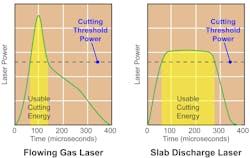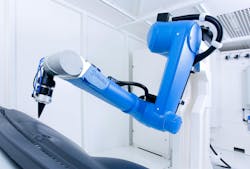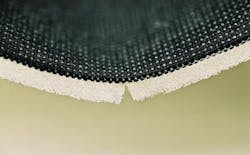Processing automotive interior components
Carbon dioxide lasers have a long history in automotive manufacturing, originally being employed for heavy-duty auto body welding applications. But over the last decade, the advent of compact, sealed CO2 lasers with improved output characteristics, together with the development of more sophisticated robotic systems, have enabled lasers to move into high-precision processing tasks for non-metallic materials, particularly components destined for automotive interiors. This article reviews some current high-precision automotive manufacturing applications and the lasers and robotic technology that service them.
Application requirements
The interior of a modern automobile (dashboard, console, doors, headliner, and so on) typically comprises a number of individual panels. These panels often have complex, three-dimensional shapes and may contain numerous holes to accommodate lights, controls, speakers, and indicators. A variety of materials are used in panel construction, the most common being textiles, natural leather, synthetic skins, a variety of plastics, and carbon fiber. Furthermore, these materials are sometimes used in multilayer combinations, such as fabric over carbon fiber.
Most commonly, the panel is first rendered into its basic shape, followed by edge trimming and the addition of holes. Any technology used for performing this trimming and hole cutting must meet several requirements in order to be viable. First and foremost, this processing must yield the cosmetic characteristics necessary for consumer acceptance of the finished product. This virtually always means the complete absence of any noticeable change to the color or texture of the outermost layer of the part, and may also include delivering processed edges that are debris free and even smooth to the touch. Process throughput is also critical in this relatively cost-sensitive application, and usually translates into feed rates that are in the 100s of millimeters per second range. Finally, uptime is also crucial, and the equipment is often expected to work in a multi-shift environment.
The laser is in many ways an ideal tool for automotive interior applications. It is a non-contact method that produces no stress on the processed part, and requires virtually no downtime for tool replacement. In contrast, mechanical cutting is limited by tool wear and downtime for tool replacement, and waterjet cutting is limited by its slower throughput. Laser processing also allows the production of smaller features and delivers tighter tolerances than alternative technologies such as mechanical cutters. Another advantage of lasers is their ability to deliver defined depth cuts (blind holes or slits that only penetrate part of the way through the workpiece).
Sealed CO2 lasers
The infrared output wavelength of CO2 lasers is well-suited to fast processing organics and other interior materials. But traditional flowing gas CO2 lasers are not economical for these applications; their high power is actually a disadvantage because it can char or discolor many commonly used materials, especially organics. Furthermore, these high-power lasers don’t deliver the beam characteristics for more precise tasks, and also are relatively expensive to operate. Consequently, the successful growth in these non-metallic applications has been directly tied to the maturation of compact, sealed CO2 lasers.
These lasers utilize a completely sealed resonator capable of delivering thousands of hours of maintenance-free operation. In addition, the use of RF discharge technology and novel cavities such as a slab discharge configuration enable these lasers to be directly pulsed with excellent power-on-demand characteristics. (This is an important benefit for cutting holes and other stop/start tasks). Plus these pulses have a fast risetime, which minimizes HAZ, and hence charring, in organics. Moreover, the use of tightly folded or slab resonators means these lasers deliver a very high power/size ratio. In addition, they are capable of delivering much better quality than a flowing gas laser. This results in superior cut quality and more efficient use of the available laser power (see Figure 1). And lastly, laser manufacturers have focused on applying modern manufacturing techniques and materials so that these lasers offer the lowest cost per photon of any industrial laser type.
Innovative robotics
In many laser-based tools for automotive interior applications, the CO2 laser is directly mounted on a robot arm. The entire laser gantry, and possibly also the workpiece, are then moved to enable processing of curved or oddly shaped parts. However, this approach has a significant drawback. In particular, despite the relatively small size of the latest CO2 lasers, the weight of the laser head slows the maximum speed at which the arm can move, thus limiting throughput. In addition, the mechanical requirement of moving the laser head constrains the maximum size and weight that can be accommodated. This limits laser size and hence laser power, which again impacts maximum achievable throughput.
Recently, JENOPTIK Automatisierungstechnik (Jena, Germany) and STÄUBLI Robotics (Pfäffikon, Switzerland), joined together to tackle this issue head-on. Together they created the JENOPTIK-VOTAN C BIM (Beam in Motion) laser robot system. This system utilizes an articulated delivery arm, similar to that found in many surgical laser systems. Specifically, the arm consists of several movable, motorized segments, each terminated with a gimbaled mirror. This configuration serves to keep the laser beam at a fixed position within the delivery arm no matter how the arm is moved in either translation or rotation. The laser is mounted outside the arm and is held stationary. The robot arm is terminated with focusing optics, and also includes lines for supplying an assist gas and for fume evacuation (see Figure 2).
This arrangement enables high-speed, accurate beam movement over a large 3D volume (1400 × 700 × 500 mm). Furthermore, movement in six degrees of freedom (x, y, z, θx, θy, θz) allows virtually any part contour to be followed, and enables the beam to be directed so that it is always incident normal to the workpiece surface. Because the laser is stationary, there is virtually no limit on its size, and hence power.
Several different versions of this system are available. The JENOPTIK-VOTAN C is for cutting, the JENOPTIK-VOTAN A is for airbag panel preweakening, and the JENOPTIK-VOTAN P is for packaging applications.
Applications
For trimming and perforating parts such as cup holders, fabric-covered door panels, covers, or inserts, the JENOPTIK-VOTAN C BIM is fitted with a 300W, Coherent Diamond K-300 CO2 laser. This particular laser is utilized because key requirements for fabric cutting are a cost-effective, small laser, with good beam quality and high peak power. These output characteristics produce a minimal HAZ, resulting in a cosmetically acceptable finish at the processed edge.
Carbon fiber parts have a different set of requirements. These parts are commonly used in the instrument panel, door panels, and steering wheels. Generally, these are processed before covering with a cosmetic material such as synthetic skin or fabric. This type of cutting is usually performed with a 500W laser. That’s because the main concern in cutting carbon fiber parts is speed; cosmetic considerations are quite secondary, because these are not seen by the consumer. In addition, it is important that the cutting process yields a clean, debris-free edge. The Coherent Diamond K-500 laser is the recommended tool of choice here because of its fast rise time and high peak power. These characteristics produce minimal melting and debris at the processed edges. In addition, the high peak power of this pulsed laser gives it the cutting capabilities and throughput rate of a CW laser with much higher power (that would also be more costly).
JENOPTIK-VOTAN A Compact is a laser system that is used for the pre-weakening of airbag panel coverings. Here, the goal is to weaken the material of the instrument panel that overlays the airbag assembly so that it will break in a predetermined manner if the airbag is deployed. However, this must be accomplished in a way that does not change the cosmetics of the overlying material, because this degradation would be visible to the consumer on the instrument panel. The covering of the instrument panel typically consists of either leather or foam-backed fabric. In the case of leather, weakening is implemented by perforating the material with a series of small holes. For fabric, the foam layer is cut through nearly completely, while the overlying fabric is left virtually untouched.
To perform these operations, the JENOPTIK-VOTAN A Compact is outfitted with a 100W continuous wave laser, such as the Coherent GEM-100. This laser was chosen because it has excellent beam quality and offers power on demand. Specifically, the low M2 beam can be focused to a small spot size, which is necessary to produce 200-300 µm diameter holes in leather, as well as to create narrow slits with precise depth control in foam-backed fabric. The beam properties of the GEM-100 also allow these organic materials to be processed without producing any charring, which would be undesirable from a cosmetic viewpoint.
In conclusion, the use of lasers, which have a well-established history in automotive manufacturing, continues to expand in the areas of non-metallic panels and components. This growth is due in part to the development of laser sources offering better performance, cost of ownership, and reliability characteristics, as well as the advent of more sophisticated and compact beam delivery systems.
About the Author
Frank Gaebler
Director of Product Marketing, Coherent LaserSystems GmbH & Co KG
Frank Gaebler is director of product marketing at Coherent LaserSystems GmbH & Co KG (Lübeck, Germany).


